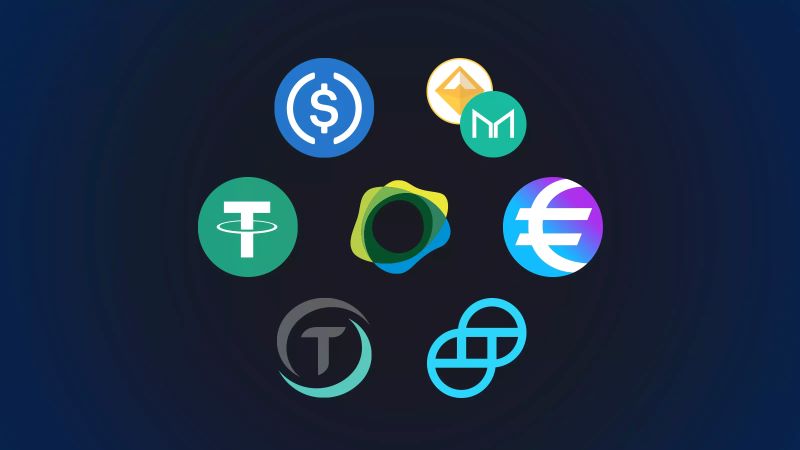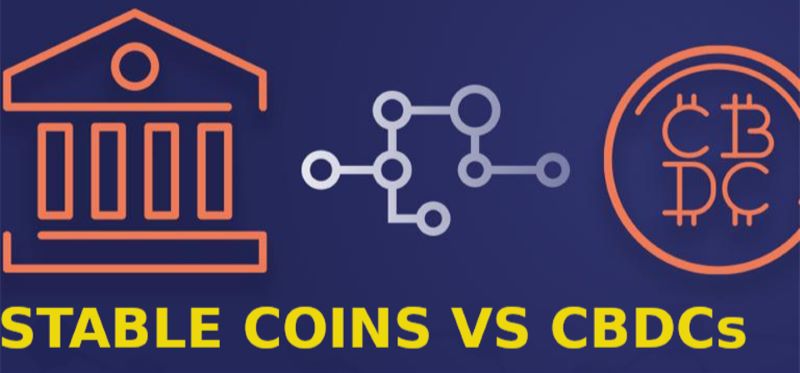What is a stable coin? If you’ve dipped a toe into the buzzing stream of cryptocurrency, you know its rapids can be wild. You might love the thrill of Bitcoin’s highs and lows, but sometimes, you need something steadier – enter the stablecoin. Imagine a digital currency with a chill vibe, not bouncing all over the place, but rather anchored to real-world assets. Here, we break down this smoother operator of the crypto world. We’ll dive into types that cling to the dollar’s steadiness or even mirror gold’s timeless value. Get ready to grasp how these crypto anchors hold their ground – even when digital storms hit.
Understanding Stablecoins: The Basics of Cryptocurrency Stability
Defining Stablecoins and Their Role in Crypto Economy
Let’s break down what a stablecoin is. Think of it as a special kind of digital money. It’s like other cryptocurrencies but with a twist – it’s stable. This stability is what makes it stand out. Instead of wild price jumps, stablecoins aim to keep their value steady over time.
How do they do this? They are tied to things that already have a set value, like dollars or gold. This tie helps them avoid the big ups and downs seen in typical cryptocurrencies. Now, why do we care about stablecoins? They make dealing with digital money easier and safer. You can buy, sell, or trade without worrying about losing value suddenly.
The Different Types of Stablecoins: From Fiat-collateralized to Algorithmic
Stablecoins come in different flavors. Each kind has its own way of staying stable. The most common type is the fiat-collateralized stablecoin. This sort is backed by real money. For every stablecoin, there is a real dollar sitting in a bank. That’s how they keep their price the same as the dollar.
But there’s more. Some stablecoins don’t use cash to stay steady. They use math and software – these are called algorithmic stablecoins. They work by adjusting the supply of the coin to keep its value in line. What does this mean? Imagine if there are too many coins and the value drops. The system will cut down on available coins to push the value back up. It’s a smart way to manage money without needing an actual vault full of cash.

Now, you may think, “Is this all really safe?” Well, these coins are new, and they do carry risks. They need careful managing and clear rules to avoid trouble. Stability isn’t an easy feat; it takes work and smart design to make it last.
From what we just talked about, it’s clear – stablecoins have a big job. They keep crypto trade smooth and support the growth of digital finance. They make using cryptocurrencies a lot less scary for folks new to this world. Stablecoins may just be one piece of the puzzle, but they’re a crucial one for making sure the future of money includes everyone.
So that’s our dip into the pool of stablecoins. They anchor the wild sea of cryptocurrencies with their steady value. And whether they’re backed by real cash or clever code, they help make sure this digital money world stays afloat for all of us.
Mechanisms Behind the Stability of Stablecoins
How Fiat-collateralized Stablecoins Like Tether Ensure Price Stability
Ever wonder how a stablecoin keeps its cool in a wild crypto market? It’s like an anchor in choppy waters. Most stay calm by holding onto real money, called fiat. Just like a video game token has a set cost, stablecoins link their value to something stable, like dollars or gold. This link keeps their prices from jumping all over the place.
Take Tether USDT, a popular stablecoin you might have heard of. Every USDT aims to be worth one US dollar. So if you’ve got 10 USDT, that’s like having 10 real dollars. They make sure of this by keeping actual dollars in a bank. Folding money, just sitting there, for every digital coin out there. This idea is simple: one USDT equals one dollar because they have a dollar for each USDT.
These coins depend on trust. People need to believe that for every coin, there’s a real dollar backing it up. Companies running these show this by sharing their bank info in a process called an audit. A clean audit says, “We’ve got the cash!”
The Complex Dynamics of Pegging Digital Currency to Traditional Assets
Now let’s dive into the nitty-gritty: pegging a stablecoin to an asset like gold or dollars. Pegging means they fix their digital coin’s value to something folks generally trust. It’s like saying, “This coin will always be worth this much gold.” This promise keeps the coin’s price from dancing to the crypto market’s wild tunes.
Crypto market stability matters to everyone, from big-time traders to folks buying their first coin. When a digital currency’s price holds steady, people trust it more for buying stuff or saving. This steadiness comes from pegging.

But, how does it work? Say a stablecoin is pegged to gold. They lock up some gold and give out coins worth that gold’s value. If gold’s price goes up or down, they might have to adjust things to keep the coin’s value right. It’s a tough job, but vital for keeping things steady.
And it’s not just all about cash and gold. Some are cooking up algorithmic stablecoins. These use smart computer programs to keep the value just right, without holding onto piles of cash or gold. It’s a newer trick and pretty nifty, but it can get complicated fast.
Digital coins that don’t wobble mean a lot for everyone. They can make trading easier and help keep prices stable in the digital markets. Big words and fancy ideas all boil down to this: stablecoins are digital money that doesn’t go on wild rides. They stay pegged, so people can use and trust them just like real money. And that, friends, is a secret worth sharing.
Stability might sound boring, but in the crypto world, it’s pure gold.
Analyzing the Stability and Risks of Stablecoins
The Benefits and Challenges of Asset-backed and Gold-pegged Stablecoins
Here we dive into what sets some stablecoins apart. Many people use digital money like Bitcoin, but its price jumps a lot. Stablecoins are different. They keep a steady price, which makes trading and buying things less risky. They are like a bridge between usual money and digital coins.
Asset-backed stablecoins have real money or other stuff worth dollars backing them. If you hold one stablecoin, you own a piece of something real. It’s like having a money promise in your digital wallet. This promise keeps its price stable. Because of that, a stablecoin doesn’t dance around much in value. It’s a safe boat in a wild sea of price waves.
But it’s not easy. Asset-backed stablecoins need a lot of checks to stay secure. They must show regularly that they truly have the assets they claim to have. This happens through audits. Without these checks, it’s like taking someone’s word without proof. People may lose trust if there’s no clear evidence of the assets.
Gold-pegged stablecoins are a special case. They tie their worth to gold’s price. This old treasure keeps its value over time. So, if the stablecoin is pegged to gold, it also holds onto its worth. These gold-backed coins mix old-world charm with new tech. This gives people a modern way to own gold without holding heavy bars.
But, remember, the price of gold can change. If its price drops, the price of the gold-pegged stablecoin dips too. Knowing these risks helps you make smart choices.
Impact of Regulation and Audits on Stablecoin Security and Trust
Rules and frequent checks are must-haves for stablecoins. They help make sure that the stablecoins are really worth what they say they are. This is where regulators step in. They set the rules to keep stablecoin trading safe and fair. Good rules help us trust that one stablecoin is truly worth one dollar, for example.
Checks, or audits, are just as important. In an audit, experts look inside to see if the stablecoin has enough assets. These assets could be money in a bank, gold, or other valuable stuff. They check if the money story adds up. If it does, we feel good about using stablecoins. This makes the coin more likely to keep its price right.
Without these checks, doubts can sneak in. If people start to doubt, they might stop using the stablecoin. That can mess with its price and make it unstable. And that’s the opposite of what a stablecoin should be!
Trust in stablecoins is built on clear rules and honest checks. This way, everyone knows the game is fair. It keeps our digital money steady. A steady coin helps us all buy, sell, and trade without worries. It’s an anchor in the fun but sometimes wild world of digital coins.
Stablecoins in the Global Economy: Adoption, Utility, and Future Prospects
The Interplay Between Decentralized Finance (DeFi) and Stablecoin Market Cap
You might wonder, what is stablecoin Market Cap? It’s the total value of all stablecoins out there. So, why does this matter? Picture a big playground. DeFi plays on one side and stablecoins on the other. They need each other. DeFi looks for safe, stable money while stablecoins need a place to be useful. Their market cap grows when there are more coins and people use them.
Think about lemonade stands in summer. More heat, more lemonade sold, right? Same here. More trust in stablecoins, more of them we see—and the more everyone uses them. Decentralized finance—the cool kid on the block—loves this. It uses stablecoins to let people lend or trade without a bank middleman.
The Evolution of Central Bank Digital Currencies (CBDC) and Their Effect on Crypto Stability
Central Bank Digital Currency (CBDC) might sound serious. But it’s like getting your weekly allowance in digital cash from your parents. It’s still real money but in digital form, issued by the country’s bank. Kinda like your favorite video game tokens, but these are for real shops, not just for upgrades or new outfits for your character.
CBDCs and stablecoins both live in digital wallets, but they come from different places. CBDCs come from central banks, while stablecoins can come from anyone who makes them right. CBDCs could make everyone feel good about digital cash, like how a bike helmet makes you feel safe. If people trust digital money more because of CBDCs, then stablecoins might get a boost too.

So, what about crypto stability? When CBDCs step in, they’re like a big anchor for a ship. They could make the wild waves of the crypto sea feel calmer. This doesn’t just keep your sail smooth but helps everyone trust the journey ahead.
In this post, we dove into the stable world of stablecoins. We started with the basics, explaining how they stay calm in a wild crypto sea. Then, we looked at the types out there, from those tied to dollars to trickier algorithmic kinds.
We then unpacked how these steady coins keep their cool, especially when they’re backed by real money or assets. Sure, sticking to something solid helps, but it’s not always simple. Things can get complex when you tie a coin to gold or cash.
We also talked risks and rewards. Backed coins are great for keeping value steady, but they come with their own baggage. And hey, don’t forget, the rules and check-ups that keep them in line matter too. These are what make people trust them.
Lastly, we explored how these digital dollars fit in our big world. From DeFi shake-ups to what might happen when big banks go digital, we covered the future of money as we might come to know it.
So, here’s the big finish: Stablecoins could really shape how we spend, save, and see money. They’re not perfect, but they’re a big step toward a future where cash is king no more. Keep an eye on these coins—they might just be the stable mates we need in an ever-changing finance world.
Q&A :
What Exactly Is A Stablecoin In Cryptocurrency?
Stablecoins are a type of cryptocurrency designed to offer stability in value by being pegged to a reserve asset, such as the US dollar, gold, or other fiat currencies. Unlike other volatile cryptocurrencies, stablecoins aim to maintain a consistent buying power, making them ideal for daily transactions, reducing risk, and acting as a haven during market turbulence.
How Do Stablecoins Maintain Their Stability?
Stablecoins maintain their stability through various mechanisms. The most common method is backing each stablecoin with a reserve of fiat currency – for example, one stablecoin equals one USD in reserve. There are also crypto-collateralized stablecoins, which use other cryptocurrencies as collateral, and algorithmic stablecoins, which use algorithms to manage the supply of the stablecoin to maintain its peg to the reserve asset.
Are Stablecoins Safe To Invest In?
The safety of investing in stablecoins depends on various parameters, including the transparency of the issuing company, the security of the underlying assets, regulatory compliance, and the stability mechanism in use. While stablecoins can reduce volatility risks, potential technical vulnerabilities or regulatory changes could affect their stability. Investors should perform due diligence before investing.
Can Stablecoins Be Redeemed For Real Money?
Yes, stablecoins can typically be redeemed for real money. They are designed to be convertible to their underlying assets at a 1-to-1 ratio, meaning you should be able to exchange one stablecoin for one unit of the fiat currency to which it’s pegged. However, the ease and process of redemption can vary between stablecoin platforms and may depend on liquidity and other factors.
What’s The Difference Between Stablecoins And Other Cryptocurrencies?
The key difference between stablecoins and other cryptocurrencies, like Bitcoin or Ethereum, is volatility. While typical cryptocurrencies experience high volatility and unpredictable price fluctuations, stablecoins aim to maintain a constant value by being tied to an external stable asset. This predictable value proposition makes stablecoins particularly useful for everyday transactions and for those looking to avoid the market’s high volatility.


